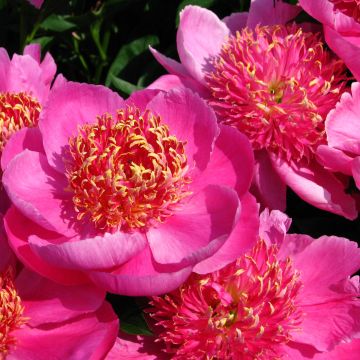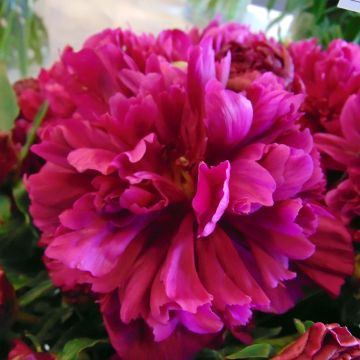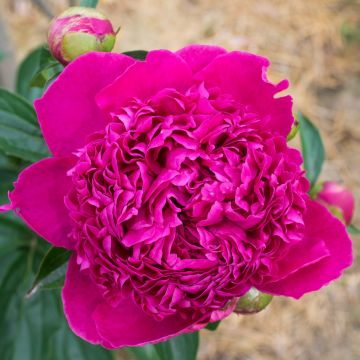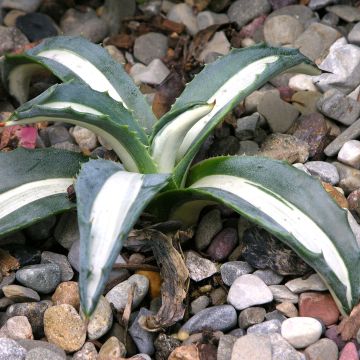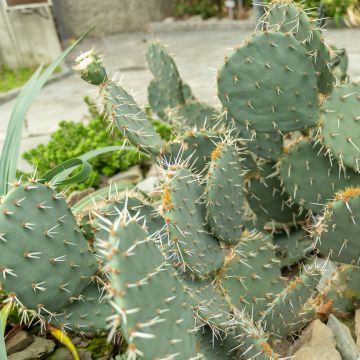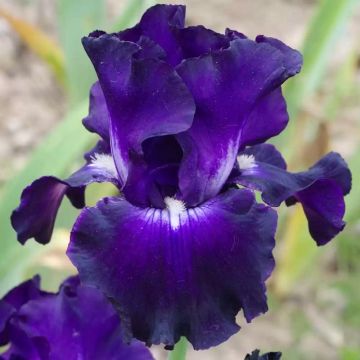

Paeonia officinalis Alba Plena


Paeonia officinalis Alba Plena


Paeonia officinalis Alba Plena
Paeonia officinalis Alba Plena
Paeonia officinalis Alba Plena
Soft-leaved Peony
Very beautiful sturdy strain with 4 buds starting to grow. I can't wait to see it bloom.
Mireille T., 28/02/2024
This item cannot be shipped to the selected country
Delivery charge from €5.90
Delivery charge from €5.90
More information
Schedule delivery date,
and select date in basket
This plant carries a 12 months recovery warranty
More information
We guarantee the quality of our plants for a full growing cycle, and will replace at our expense any plant that fails to recover under normal climatic and planting conditions.
From €5.90 for pickup delivery and €6.90 for home delivery
Express home delivery from €8.90.
From €5.90 for pickup delivery and €6.90 for home delivery
Express home delivery from €8.90.
Does this plant fit my garden?
Set up your Plantfit profile →
Description
Paeonia officinalis Alba Plena is one of the oldest varieties directly derived from Paeonia officinalis. The one that was called the "peasant's peony", the Paeonia officinalis Rubra Plena, born as usual from a big red bud, slowly unfolding into a curious pink pompom, one day appeared in full bloom in a tangle of pure white petals. Double, globular, of medium size, its delicately scented flower is one of the first to bloom, after its double red mother and the simple wild form. This robust garden perennial has round foliage of fairly light green that autumn paints red, magnificent in late-season floral compositions.
Paeonia officinalis is native to central and southern Europe. Like all peonies, it belongs to the renonculaceae family (now peony family). There are several subspecies and varieties of officinal peony, including the Alba Plena form, with pure white double flowers.
'Alba Plena' is a fleshy rhizomatous herbaceous plant, very hardy. Its growth is slow during the first years, eventually forming a bushy clump of 60-70cm (24-28in) in all directions, the clump slowly spreading thanks to its fleshy roots. Its stems bear leaves divided into leaflets that are divided into lanceolate segments with entire edges, not very pointed at their tips. The blade, slightly satin, is of a fairly light green, grey and finely hairy on the underside. The flowering lasts for 4 to 6 weeks, usually starting in early May depending on the climate. The solitary flowers, 14cm (6in) wide, appear at the tips of the stems, in the form of red or pink buds. When they open, they are pink, often streaked with red, then quickly fade to pure white. Each flower is composed of thin, translucent and slightly wrinkled petals, which appear marbled in length. The weight of the flowers bends the stems, which often need to be staked. Note that this peony is usually sterile and that its longevity is excellent, sometimes exceeding the duration of a human life.
Peonies are part of those plants that constitute the basis of a garden. Formerly, not so long ago, every garden, from the most modest to the most elaborate, proudly displayed clumps covered with fragrant flowers that made their way into the house, keeping company in each bouquet with purple lilacs and blue bellflowers. The Alba Plena peony, incredibly sturdy once established, yet full of charm and sweetness, deserves a place in every flower garden. It thrives in large borders, in full light to flower generously. However, avoid west-facing exposures in warm climates. A clump of Paeonia officinalis Alba Plena in full bloom forms a very nice gradient of red, pink, and white. It can be combined with a wide range of timeless and unpretentious perennials such as columbines, bellflowers, foxgloves, garden irises, carnations, oxeye daisies, or Christmas roses. Cultivating it in a pot is not recommended, as its needs will not be met. Over time, the peony becomes majestic, multiplies, and blooms more and more abundantly. Give a beautiful gift to those who are dear to you: offer them a peony!
Properties:
This species of peony was already prized in the Middle Ages, where it featured in the herb garden. Its root was attributed with anti-epileptic, anti-spasmodic, and narcotic properties. Modern science has demonstrated the presence of specific alkaloids with therapeutic purposes in this plant. Note that the first horticultural varieties created in the late sixteenth century, such as Alba Plena, are still cultivated in our gardens.
Report an error about the product description
Paeonia officinalis Alba Plena in pictures




Flowering
Foliage
Plant habit
Botanical data
Paeonia
officinalis
Alba Plena
Ranunculaceae (Paeoniaceae)
Soft-leaved Peony
Cultivar or hybrid
Other Herbaceous and hybrid Peonies
Planting and care
The Alba Plena peony, like all peonies, does not like to be moved, so you have to think carefully about the right place to plant it. The best time to plant them is in spring or autumn. Plant the stumps in a clear, sunny location, in clayey but well-drained and loosened soil, possibly enriched with humus. Peonies need space and dislike competition from other species. Prepare a hole of 50 x 50 x 50cm (20in), add a thin layer of coarse sand or gravel at the bottom of the hole to drain the roots, mix organic fertilizer into your soil, partially refill, place your plants and cover with 6cm (2in) of soil above the buds. After planting, tamp down and water generously. Once established, this peony can do without watering in summer in most temperate regions, except in hot and dry climates where abundant watering every 15 days will be greatly appreciated.
Planting period
Intended location
Care
-
, onOrder confirmed
Reply from on Promesse de fleurs
Mediterranean perennials
Haven't found what you were looking for?
Hardiness is the lowest winter temperature a plant can endure without suffering serious damage or even dying. However, hardiness is affected by location (a sheltered area, such as a patio), protection (winter cover) and soil type (hardiness is improved by well-drained soil).

Photo Sharing Terms & Conditions
In order to encourage gardeners to interact and share their experiences, Promesse de fleurs offers various media enabling content to be uploaded onto its Site - in particular via the ‘Photo sharing’ module.
The User agrees to refrain from:
- Posting any content that is illegal, prejudicial, insulting, racist, inciteful to hatred, revisionist, contrary to public decency, that infringes on privacy or on the privacy rights of third parties, in particular the publicity rights of persons and goods, intellectual property rights, or the right to privacy.
- Submitting content on behalf of a third party;
- Impersonate the identity of a third party and/or publish any personal information about a third party;
In general, the User undertakes to refrain from any unethical behaviour.
All Content (in particular text, comments, files, images, photos, videos, creative works, etc.), which may be subject to property or intellectual property rights, image or other private rights, shall remain the property of the User, subject to the limited rights granted by the terms of the licence granted by Promesse de fleurs as stated below. Users are at liberty to publish or not to publish such Content on the Site, notably via the ‘Photo Sharing’ facility, and accept that this Content shall be made public and freely accessible, notably on the Internet.
Users further acknowledge, undertake to have ,and guarantee that they hold all necessary rights and permissions to publish such material on the Site, in particular with regard to the legislation in force pertaining to any privacy, property, intellectual property, image, or contractual rights, or rights of any other nature. By publishing such Content on the Site, Users acknowledge accepting full liability as publishers of the Content within the meaning of the law, and grant Promesse de fleurs, free of charge, an inclusive, worldwide licence for the said Content for the entire duration of its publication, including all reproduction, representation, up/downloading, displaying, performing, transmission, and storage rights.
Users also grant permission for their name to be linked to the Content and accept that this link may not always be made available.
By engaging in posting material, Users consent to their Content becoming automatically accessible on the Internet, in particular on other sites and/or blogs and/or web pages of the Promesse de fleurs site, including in particular social pages and the Promesse de fleurs catalogue.
Users may secure the removal of entrusted content free of charge by issuing a simple request via our contact form.
The flowering period indicated on our website applies to countries and regions located in USDA zone 8 (France, the United Kingdom, Ireland, the Netherlands, etc.)
It will vary according to where you live:
- In zones 9 to 10 (Italy, Spain, Greece, etc.), flowering will occur about 2 to 4 weeks earlier.
- In zones 6 to 7 (Germany, Poland, Slovenia, and lower mountainous regions), flowering will be delayed by 2 to 3 weeks.
- In zone 5 (Central Europe, Scandinavia), blooming will be delayed by 3 to 5 weeks.
In temperate climates, pruning of spring-flowering shrubs (forsythia, spireas, etc.) should be done just after flowering.
Pruning of summer-flowering shrubs (Indian Lilac, Perovskia, etc.) can be done in winter or spring.
In cold regions as well as with frost-sensitive plants, avoid pruning too early when severe frosts may still occur.
The planting period indicated on our website applies to countries and regions located in USDA zone 8 (France, United Kingdom, Ireland, Netherlands).
It will vary according to where you live:
- In Mediterranean zones (Marseille, Madrid, Milan, etc.), autumn and winter are the best planting periods.
- In continental zones (Strasbourg, Munich, Vienna, etc.), delay planting by 2 to 3 weeks in spring and bring it forward by 2 to 4 weeks in autumn.
- In mountainous regions (the Alps, Pyrenees, Carpathians, etc.), it is best to plant in late spring (May-June) or late summer (August-September).
The harvesting period indicated on our website applies to countries and regions in USDA zone 8 (France, England, Ireland, the Netherlands).
In colder areas (Scandinavia, Poland, Austria...) fruit and vegetable harvests are likely to be delayed by 3-4 weeks.
In warmer areas (Italy, Spain, Greece, etc.), harvesting will probably take place earlier, depending on weather conditions.
The sowing periods indicated on our website apply to countries and regions within USDA Zone 8 (France, UK, Ireland, Netherlands).
In colder areas (Scandinavia, Poland, Austria...), delay any outdoor sowing by 3-4 weeks, or sow under glass.
In warmer climes (Italy, Spain, Greece, etc.), bring outdoor sowing forward by a few weeks.


































